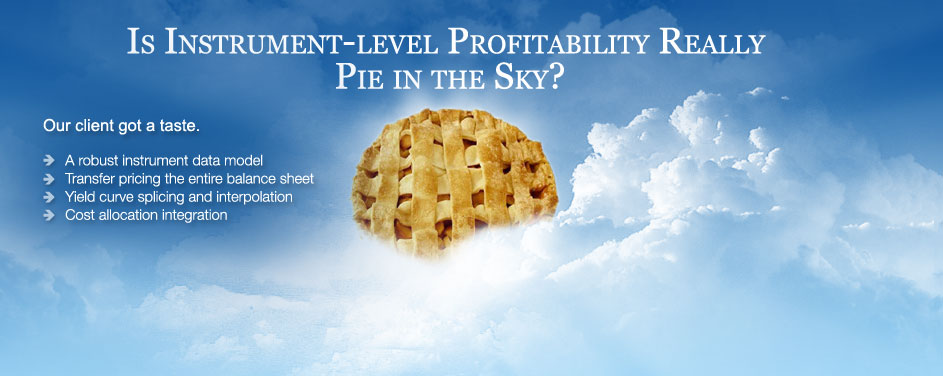
CLIENT
A Top 10 (by assets) US bank
CHALLENGE
Traditional savings and loan banks are in the business of taking deposits to then lend out, earning a spread between the interest paid and received. On the surface, loans are cash cows, generating all of the revenue, while deposits appear as dogs, producing the interest expense necessary to fund the loan book.
Some mechanism is necessary to risk-adjust the spread a bank earns, by product, as administered and managed through a central treasury function. Deposits earn a credit for their worth in funding assets. Loans incur a cost for the expense involved in securing capital to lend. This concept can extend to every position on the balance sheet: every liability has some benefit operationally, while every asset has a cost.
On the income statement, non-interest expenses, associated to servicing, marketing, and administration overhead, exist that don’t easily associate to the products, departments and customers that they support. Organizations must devise a method to allocate these overhead costs back to the areas that generate revenue.
Once the balance sheet and income statement are normalized for profitability, data consumers can analyze any slice of data, down to the lowest grain of instrument (customer account), and understand its fully expense-loaded, risk-adjusted contribution.
With a mandate for improved corporate profitability reporting, our client engaged us to build a comprehensive solution for risk-adjusted profitability. Calculate instrument-level profitability in the commercial loan and deposit books. Transfer price the entire balance sheet. Allocate service overhead costs dimensionally, providing a fully cost-loaded product profitability view. Consolidate all profitability data into a central data store for enterprise consumption. In short, paint a picture of granular, risk-adjusted profitability, accounting for interest rate, liquidity, prepayment and credit risks, as well as costs to market, service, and operate the revenue-generating product lines.
IDEAS
In collaboration with an enterprise software vendor, our ideas centered on four conceptual areas: 1) Transfer price the commercial loan and deposit businesses at the lowest grain of detail to leverage pricing and cash flow information; 2) allocate overhead costs to dimensions not available on the corporate ledger; 3) compile all profitability calculations in a performance ledger; 4) report dimensionalized net interest margin and net profitability contribution.
The details of these ideas are as follows:
1) Instrument Profitability
- Model the commercial loan and deposit books of business at the instrument level (customer account), leveraging a robust, granular data model to fully describe their pricing and cash flow characteristics and dimensional attributes of product, customer and department.
- Transfer price the indeterminate term deposit products according to their “core” stable balance levels using the yield of an assumed term, averaged over that same period, e.g., 3 month moving average of the 3 month LIBID.
- Transfer price the term loans and deposits using a yield curve that splices fed funds, LIBOR/BID, and SWAP rates, with appropriate bid/ask spread adjustments. Use linear interpolation to bridge observed quotation points, reflecting the convexity of the interest rate environment at the time and the bank’s pricing policies.
- Based on empirical evidence, assume minimal or no adjustments for prepayment risk.
- Transfer price the repricing loans according to a repricing schedule, allowing for irregular periodic schedules by instrument.
- Include a liquidity adjustment cost for the reprice method loans, given that the full term of funding is longer than the reprice term.
- Use currency-specific yield curves, using the transaction currency to drive pricing, reflecting the liquidity profile of each currency.
- Choose AA rated swap curves, reflecting the client’s credit costs as a counterparty in swap transactions.
2) Cost Allocation
- Identify non-interest expense accounts relating to overhead costs. Use cost drivers to dimensionalize the expense numbers, driving them back to the products and customers that necessitated their expenditure.
- Use the official general ledger as the input source and the performance ledger as the target, creating a single source of dimensionalized profitability data.
3) Performance Ledger Modeling
- Import the full balance sheet and income statement ledgers from the source of 10K and 10Q reporting, lagging month-end to allow for adjustments during the GL close process.
- For those GL dimensions that match the available instrument detail, perform a GL reconciliation. Plug any difference between the instrument and GL balances such that the GL amount dominates, allowing a profitability perspective that reflects the official books and records.
- Leverage the instrument detail to aggregate to the ledger level, dimensionalizing the ledger data by product, customer and channel. Use the rule: instrument detail + reconciliation plugs = ledger amount.
- For GL positions without instrument detail, assume a term and yield curve for pricing, or a stated basis point charge or credit.
- Base processing off of a tree that logically depicts groupings of GL accounts in hierarchies, associating transfer pricing rules to clusters with identical functional treatment.
- Recursively process each account with the lowest level rule associated to it until all accounts are processed, ensuring transfer pricing of the entire balance sheet.
- Identify inter-company accounts (positions between internal departments) and transfer price them at a 0 rate, effectively eliminating a charge or credit for these balances.
- Some bank branches have standing agreements with the treasury group to receive pricing based on a pre-arranged spread against a defined index. For the accounts under these branches, calculate a transfer price cost or credit as a basis point spread against the stated index.
- Post the transfer pricing output to income statement profitability accounts, representing the cost or worth of funds for each balance sheet position.
4) Reporting
- With transfer pricing and cost allocations compiled in a central performance ledger, generate dimensionalized profitability reports that detail the components of net contribution for customer-facing products:
ASSETS LIABILITIES
Interest Income Transfer Pricing Credit
+Fee Income +Liquidity Credit
-Transfer Pricing Cost +Fee Income
-Liquidity Costs -Interest Expense
-Overhead Costs -Overhead Costs
NET CONTRIBUTION NET CONTRIBUTION
- Generate net interest margin reports, isolating the raw spread between external interest rate and the cost or worth of funds.
- Make reports flexible to include the cost of allocated capital, representing external credit, market, and operational risks, to be calculated in a future initiative.
SOLUTION
eBIS led a team consisting of client and partner resources and delivered a robust data capture, processing architecture and reporting framework for profitability analysis. We overcame a number of obstacles during this engagement: a change in business strategy partner, functional gaps in vendor software, and a significant customization to facilitate index spread processing, to name a few. Throughout, our client trusted us to lead the way, leaning on our ability to bridge gaps and deliver the right business solution.
In the end, our profitability solution was the first at this client to consolidate profitability calculations on a single platform, enabling a central definition of business rules and consistent analysis of dimensionalized, risk adjusted profitability.
RESULTS
Is an 18 month CD more profitable than an 18 month unsecured commercial loan? Does it depend on the customers involved? On the surface, counter-intuitive questions, but ones that, if answered effectively, provide great insight into how to manage customers and products, adjust operational incentives, and efficiently allocate future capital.
eBIS delivered a solution to help answer these questions. It’s great tasting pie, one that can help your business not just grow, but grow in the right direction.

